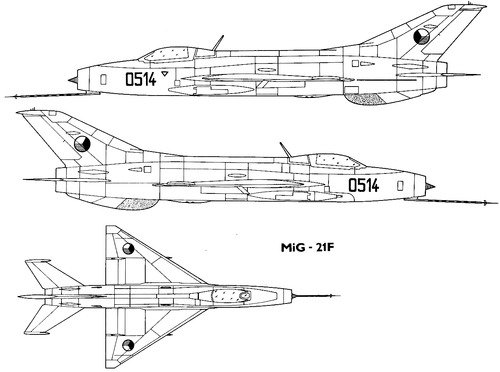A fast and highly maneuverable aircraft, the MiG-21 was produced in vast quantities and widely used by the former Soviet Union and other nations.
Built to counteract the threat of United States Air Force (USAF) B-52 bombers, the MiG-21 was capable of flight over Mach 2 and had a service ceiling of at least 60,000 feet. First produced in 1959, the MiG-21F began arriving to Warsaw Pact countries in 1962. MiG-21F aircraft were equipped with a Tumansky R-11F engine, which gave the aircraft 13,120 pounds of thrust—a ten percent increase from previous variants. They were also equipped with a 129-gallon drop tank, a multi-channel radio, identification, friend or foe (IFF) capability and radar warning receiver and many other additions. These aircraft were used by thirty countries and they have fought in almost every major conflict in the modern world.

Serial Number: 585
Manufacturer: Mikoyan and Guryevich Design Bureau
Crew: One
Engines: One Tumansky R-11F-300 turbojet; 12,675 pounds thrust
Wingspan: 23 feet 6 inches
Length: 43 feet 2 inches
Height: 13 feet 2 inches
Weight: 10,079 pounds (empty); 19,080 pounds (maximum)
Speed: 550 mph (cruising); 1,385 mph, Mach 2.05 (maximum)
Range: 1,038 miles
Service Ceiling: 61,000 feet
Armament: One NE-30 30mm cannon and two K-13A air-to-air missiles
Cost: $2,900,000
The MiG-21F on display was manufactured in the 1950s by the Mikoyan and Guryevich Design Bureau and was acquired by Hill Aerospace Museum and placed on display in July 1993.
A fast and highly maneuverable aircraft, the MiG-21 was produced in vast quantities and widely used by the former Soviet Union and other nations.
Compared to modern fighter aircraft, the MiG-21 is considered obsolete. However, because the majority of other air forces across the globe are not fielding the latest generation of cutting-edge fighter aircraft, the MiG is a more than capable aircraft.
Unfortunately, due to the aircraft’s popularity and aged airframe, the aircraft is simply more likely to have higher crash rates than other, less popular airframes.
As the airframe has aged, with production first beginning in 1959, nearly 300 aircraft have crashed, thus earning its nickname the Flying Coffin.